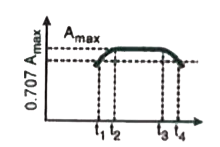A signal of 5 kHz frequency is amplitude modulated on a carrier wave of frequency 2 MHz. The frequencies of the resultant signal is/are : Solution in Kannada
2 MHz only
2005 kHz, and 1995 kHz
2005 kHz,2000 kHz and 1995 kHz
200 kHz and 1995 kHz.
The correct Answer is:C
.
KHz
Resultant frequencies are :
KHz.
Topper's Solved these Questions
- SOLIDS & SEMICONDUCTOR DEVICESBook:MODERN PUBLICATIONChapter:SOLIDS & SEMICONDUCTOR DEVICESExercise:Recent Competitive Questions
Explore 26 Videos
- SOLIDS & SEMICONDUCTOR DEVICESBook:MODERN PUBLICATIONChapter:SOLIDS & SEMICONDUCTOR DEVICESExercise:Revision Test
Explore 28 Videos
- SOLIDS & SEMICONDUCTOR DEVICESBook:MODERN PUBLICATIONChapter:SOLIDS & SEMICONDUCTOR DEVICESExercise:Multiple Choice Questions - LEVEL -II
Explore 58 Videos
- ROTATIONAL MOTIONBook:MODERN PUBLICATIONChapter:ROTATIONAL MOTIONExercise:RCQ
Explore 8 Videos
- TRANSFERENCE OF HEAT Book:MODERN PUBLICATIONChapter:TRANSFERENCE OF HEAT Exercise:Recent Competitive Questions
Explore 4 Videos
Similar Questions
The forbidden energy gap in Ge in 0.72 eV Given, hc=12400 eV−Å The maximum wavelength of radiation that will generate electron hole pair is
View SolutionChoose the forward biased p-n junction :
View SolutionThe frequency response curve of RC coupled amplifier is shown in figure . The band width of the amplifier will be :

View SolutionThe moment of inertia of a circular disc of radius 2 m and mass 1 kg about an axis passing through the centre of mass but perpendicular to the plane of the disc is 2 kg m2. Its moment of inertia about an axis parallel to this axis but passing through the edge of the disc is :

View SolutionTwo slabs are of the thicknesses d1 and d2. Their thermal conductivities are K1 and K2 respectively They are in series. The free ends of the combination of these two slabs are kept at temperatures θ1 and θ2. Assume θ1>θ2. The temperature θ of their common junction is
View SolutionA single of 5 kHz frequency is amplitude modulated on a carrier wave of frequency 2 MHz. The frequencies of the resultant signal is/are :-
View Solution5 kHz आवृति के किसी संकेत (सिगनल) का 2 महज़ आवृति की वाहक तरंग पर आयाम मॉडुलन किया गया है, तो परिणामी सिगनल (संकेत) की आवृति होगी:
View SolutionA speech signal of 3 kHz is used to modulate a carrier signal of frequency 1 MHz, using amplitude modulation. The frequencies of the sidebands will be
View SolutionA signal of 5 kHz frequency is amplitude modulated on a carrier wave of frequency 2 MHz. The frequencies of the resultant signal is/ are
View SolutionA signal of 5 kHz frequency is amplitude modulated on a carrier wave of frequency 2 MHz. What are the frequencies of the sidebands produced?
View SolutionA single of 5 kHz frequency is amplitude modulated on a carrier wave of frequency 2 MHz. The frequencies of the resultant signal is/are :-
View Solution3 किलोहर्ट्स आवृत्ति का वाक् सिग्नल, 1 मेगाहर्ट्स आवृत्ति के एक वाहक सिग्नल को आयाम माडुलीकरण द्वारा माडुलित करने के लिए प्रयुक्त किया गया है। पार्श्व बैण्डों की आवृत्तियाँ होगी
View Solution3 kHz आवृत्ति का एक वाक् सिग्नल, 1 MHz आवृत्ति के एक वाहक सिग्नल को आयाम माडुलीकरण द्वारा माडुलित करने के लिए प्रयुक्त किया गया है। पार्श्व बैण्डों की आवृत्तियाँ होंगी
View SolutionA single of 5 kHz frequency is amplitude modulated on a carrier wave of frequency 2 MHz. The frequencies of the resultant signal is/are :-
View Solution5 kHz आवृत्ति का एक संकेत 2 MHz आवृत्ति की एक वाहक तरंग पर आयाम मॉडूलित होता है। परिणामी संकेत की आवृत्तियाँ है/हैं :
View Solution
